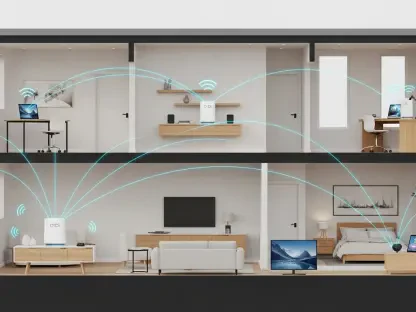The landscape of sensor technology is rapidly transforming, spurred by exponential growth in technological innovations and increasing demand across sectors such as telecommunications, defense, and connected devices. The Wideband Sensor Market is positioned for robust growth, projected to expand at a Compound Annual Growth Rate (CAGR) of 9.88% from now until 2032. This anticipated growth trajectory underscores the pivotal role wideband sensors play in modernizing infrastructure and meeting the comprehensive needs of high-speed, low-latency communication systems. These sensors stand as key enablers for the infrastructure of 5G technology, autonomous vehicles, Internet of Things (IoT) devices, and essential defense systems.
Technological and Application Drivers
5G Infrastructure and Telecommunications Revolution
The telecommunications sector is witnessing a monumental shift driven by the need for high-speed data transmission, and wideband sensors are at the heart of this transformation. These sensors are pivotal in developing and enhancing 5G infrastructure, which requires ultra-wideband capabilities to manage the expansive frequency range demands of modern communication systems. The integration of wideband sensors in telecommunications empowers networks to deliver seamless low-latency experiences essential for applications like video streaming and online gaming. As global telecom companies accelerate 5G rollouts, the demand for advanced wideband sensors continues to rise significantly, promising improved network efficiency.
Moreover, the blended capabilities of wideband sensors support various telecommunication operators in optimizing resource allocation and frequency utilization, ensuring that networks can efficiently handle increased traffic loads. The deployment of 5G infrastructure necessitates these sensors to streamline data paths, maintain connectivity quality, and facilitate reliable communications. This burgeoning demand underscores the vital role of wideband sensors in creating a robust telecommunication framework, hinting at sustained market prominence beyond 2032 as IoT ecosystems expand and connectivity remains paramount.
IoT and Autonomous Vehicle Integration
The proliferation of IoT and the advent of autonomous vehicles have heralded new opportunities for wideband sensors, where real-time data processing and low-latency communication are crucial. Wideband sensors serve as the backbone of IoT devices, supporting the seamless connectivity and data exchange essential for device interoperability. They enable efficient interaction in smart environments, contributing to enhanced operational efficiency and user experience. This connectivity allows for robust machine-to-machine communication necessary for intelligent home solutions, industrial automation, and healthcare systems that leverage IoT.
Similarly, the autonomous vehicle industry relies heavily on these sensors to support advanced driver assistance systems (ADAS) and vehicle-to-everything (V2X) communication. By ensuring precise data collection and real-time response to environmental cues, wideband sensors are fundamental to safe and efficient autonomous navigation. As manufacturers continue to refine these technologies, the need for sensors that deliver high-speed data analysis and robust signal handling remains integral. Hence, as IoT and autonomous vehicles gain greater market penetration, the demand for wideband sensors in these sectors is set to accelerate, highlighting their essential role in future innovations.
Market Dynamics and Regional Insights
Government Initiatives and Smart City Development
The push towards smart city development globally is a critical dynamic driving the Wideband Sensor Market. Government initiatives to enhance urban infrastructure align perfectly with the capabilities of wideband sensors, which are essential in projects requiring high-speed data processing and environmental monitoring. These sensors provide the backbone for smart traffic management, pollution control, public safety, and efficient urban planning. Cities adopting smart solutions benefit from real-time analytics and automated responses facilitated by comprehensive sensor networks, enhancing livability and sustainability.
Technological progress, particularly in antenna design, including miniaturization and energy efficiency, further amplifies the capabilities of wideband sensors. This progress supports a range of smart city applications, where diverse environmental conditions demand advanced sensor adaptability and resilience. As urban areas aim for smarter infrastructure, the role of wideband sensors as critical data aggregators and communicators becomes increasingly prominent, indicating a significant rise in market opportunities linked to smart city evolution and expansion.
Regional Market Segmentation
From a geographical perspective, North America asserts itself as a dominant force in the Wideband Sensor Market, primarily due to its advanced telecom infrastructure, significant defense expenditures, and early adoption of 5G technologies. The United States, in particular, leads in research and development efforts, contributing to a well-established infrastructure that fosters market growth. Meanwhile, Europe showcases substantial presence across the aerospace, smart city, and automotive sectors, leveraging its strong industrial base and regulatory support for technological advancements.
The Asia-Pacific region stands out as the fastest-growing market, driven by rapid 5G deployment in China, India, Japan, and South Korea. This region’s burgeoning technological landscape and growing consumer base fuel market expansion. In contrast, South America and the Middle East and Africa represent emerging regions where smart infrastructure and modernization programs in the defense sector provide significant growth potential. This geographical segmentation illustrates the diverse regional opportunities and competitive landscape shaping the future of wideband sensor technology.
Industry Innovators and Opportunities
Leading Companies and Innovation
Several key companies are influencing the trajectory of the Wideband Sensor Market, investing heavily in research and development to innovate sensor technologies. Industry giants like Lockheed Martin, Northrop Grumman, and Raytheon Technologies spearhead advancements in sensor miniaturization, increased energy efficiency, and enhanced signal processing. These companies continually strive to develop cutting-edge wideband sensors that meet the rigorous demands of sectors ranging from telecommunications to defense, ensuring product reliability and performance.
The focus on creating compact, lightweight, and energy-efficient sensors is driven by the need for versatile solutions that cater to a wide array of applications. Innovations in this space not only enhance current sensor capabilities but also open doors to new application areas, encouraging growth and diversification in the market. The continued emphasis on technological innovation positions these companies as leaders in ushering forward the next generation of wideband sensor solutions, adeptly meeting the challenges posed by an increasingly connected world.
Emerging Trends and Technological Advancements
The sensor technology landscape is undergoing a rapid transformation due to the surge in technological advancements and growing demand across various sectors, including telecommunications, defense, and connected devices. The Wideband Sensor Market is set for significant expansion, with projections indicating a Compound Annual Growth Rate (CAGR) of 9.88% until 2032. This growth emphasizes the crucial role wideband sensors play in modernizing infrastructure along with addressing the needs of high-speed and low-latency communication systems. These sensors are vital for the infrastructure supporting 5G technology, autonomous vehicles, Internet of Things (IoT) devices, and pivotal defense systems. As these sectors continue to evolve, the importance of wideband sensors cannot be overstated. They function as integral components that enable seamless connectivity and ensure efficient operation in increasingly complex and demanding technological environments. The integration of these sensors is not merely an option but a necessity for advancing modern communication networks and defense mechanisms.









